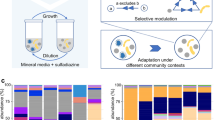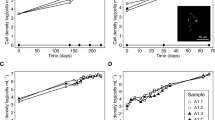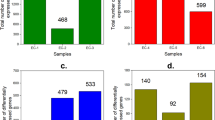Abstract
Life’s organic molecules are built with diverse functional groups that enable various importance biological functions. As such, the discovery of unique functional groups in nature can expand our understanding of the natural world. Here we report the genome-aided discovery of sulfenicin, a polyketide–non-ribosomal peptide hybrid natural product from a marine Streptomyces bacterium bearing a unique acylsulfenic acid functionality. Through a series of heterologous biosynthesis, functional genetics and enzymatic reconstitution experiments, we show that this previously described synthetic functional group is biologically assembled by a set of enzymes from both primary and secondary metabolism, including a flavin-dependent S-hydroxylase that hydroxylates the sulfur atom of a thiocarboxylic acid. Although public databases so far include no parallel for the sulfenicin biosynthetic gene cluster, enzymes catalysing the production of acylsulfenic acid are widely distributed in bacterial genomes, implying that this labile functional group may similarly have a broad distribution among specialized metabolites.

This is a preview of subscription content, access via your institution
Access options
Access Nature and 54 other Nature Portfolio journals
Get Nature+, our best-value online-access subscription
$32.99 / 30 days
cancel any time
Subscribe to this journal
Receive 12 print issues and online access
$259.00 per year
only $21.58 per issue
Buy this article
- Purchase on SpringerLink
- Instant access to full article PDF
Prices may be subject to local taxes which are calculated during checkout






Similar content being viewed by others
Data availability
The X-ray crystallographic coordinate for 1-Cu(II) reported in this study has been deposited at the Cambridge Crystallographic Data Centre (CCDC), under the CCDC number 2387232. These data can be obtained free of charge from the CCDC at www.ccdc.cam.ac.uk/data_request/cif. The genome sequence data of Streptomyces sp. CNT360 is available on JGI at https://genome.jgi.doe.gov (project ID 1016045). Experimental data supporting the conclusions of this study are available within the article and its Supplementary Information. Source data containing accession numbers and information of proteins used for SSN analysis are provided. Source data are provided with this paper.
References
Schneider, Y. K. Bacterial natural product drug discovery for new antibiotics: strategies for tackling the problem of antibiotic resistance by efficient bioprospecting. Antibiotics 10, 842–856 (2021).
Adnani, N., Rajski, S. R. & Bugni, T. S. Symbiosis-inspired approaches to antibiotic discovery. Nat. Prod. Rep. 34, 784–814 (2017).
Sekurova, O. N., Schneider, O. & Zotchev, S. B. Novel bioactive natural products from bacteria via bioprospecting, genome mining and metabolic engineering. Microb. Biotechnol. 12, 828–844 (2019).
Bauman, K. D., Butler, K. S., Moore, B. S. & Chekan, J. R. Genome mining methods to discover bioactive natural products. Nat. Prod. Rep. 38, 2100–2129 (2021).
Yee, D. A. et al. Genome mining for unknown–unknown natural products. Nat. Chem. Biol. 19, 633–640 (2023).
Dunbar, K. L., Scharf, D. H., Litomska, A. & Hertweck, C. Enzymatic carbon–sulfur bond formation in natural product biosynthesis. Chem. Rev. 117, 5521–5577 (2017).
Feng, M., Tang, B., Liang, S. H. & Jiang, X. Sulfur containing scaffolds in drugs: synthesis and application in medicinal chemistry. Curr. Top. Med. Chem. 16, 1200 (2016).
Francioso, A., Baseggio Conrado, A., Mosca, L. & Fontana, M. Chemistry and biochemistry of sulfur natural compounds: key intermediates of metabolism and redox biology. Oxid. Med. Cell. Longev. 2020, 8294158 (2020).
Jiang, C.-S., Müller, W. E. G., Schröder, H. C. & Guo, Y.-W. Disulfide- and multisulfide-containing metabolites from marine organisms. Chem. Rev. 112, 2179–2207 (2012).
Liu, Y.-P. et al. Triterpene and sterol derivatives from the roots of Breynia fruticosa. J. Nat. Prod. 74, 1161–1168 (2011).
Shi, Y.-M. et al. Global analysis of biosynthetic gene clusters reveals conserved and unique natural products in entomopathogenic nematode-symbiotic bacteria. Nat. Chem. 14, 701–712 (2022).
Hou, L. et al. Identification and biosynthesis of pro-inflammatory sulfonolipids from an opportunistic pathogen Chryseobacterium gleum. ACS Chem. Biol. 17, 1197–1206 (2022).
Seebeck, F. P. In vitro reconstitution of mycobacterial ergothioneine biosynthesis. J. Am. Chem. Soc. 132, 6632–6633 (2010).
Hu, W. et al. Bioinformatic and biochemical characterizations of C–S bond formation and cleavage enzymes in the fungus Neurospora crassa ergothioneine biosynthetic pathway. Org. Lett. 16, 5382–5385 (2014).
Burn, R., Misson, L., Meury, M. & Seebeck, F. P. Anaerobic origin of ergothioneine. Angew. Chem. Int. Ed. 56, 12508–12511 (2017).
Cheng, R. et al. Single-step replacement of an unreactive C–H bond by a C–S bond using polysulfide as the direct sulfur source in the anaerobic ergothioneine biosynthesis. ACS Catal. 10, 8981–8994 (2020).
Kenney, G. E. et al. The biosynthesis of methanobactin. Science 359, 1411–1416 (2018).
Park, Y. J. et al. A mixed-valent Fe(II)Fe(III) species converts cysteine to an oxazolone/thioamide pair in methanobactin biosynthesis. Proc. Natl Acad. Sci. USA 119, e2123566119 (2022).
Patteson, J. B. et al. Biosynthesis of fluopsin C, a copper-containing antibiotic from Pseudomonas aeruginosa. Science 374, 1005–1009 (2021).
Ting, C. P. et al. Use of a scaffold peptide in the biosynthesis of amino acid-derived natural products. Science 365, 280–284 (2019).
Yu, Y. & Van Der Donk, W. A. Biosynthesis of 3-thia-α-amino acids on a carrier peptide. Proc. Natl Acad. Sci. USA 119, e2205285119 (2022).
Meng, S. et al. Thiocysteine lyases as polyketide synthase domains installing hydropersulfide into natural products and a hydropersulfide methyltransferase. Nat. Commun. 12, 5672 (2021).
Ma, M., Lohman, J. R., Liu, T. & Shen, B. C–S bond cleavage by a polyketide synthase domain. Proc. Natl Acad. Sci. USA 112, 10359–10364 (2015).
Sinner, E. K., Li, R., Marous, D. R. & Townsend, C. A. ThnL, a B12-dependent radical S-adenosylmethionine enzyme, catalyzes thioether bond formation in carbapenem biosynthesis. Proc. Natl Acad. Sci. USA 119, e2206494119 (2022).
Zeng, Y. et al. Biosynthesis of albomycin δ2 provides a template for assembling siderophore and aminoacyl-tRNA synthetase inhibitor conjugates. ACS Chem. Biol. 7, 1565–1575 (2012).
Chen, X. & Li, B. How nature incorporates sulfur and selenium into bioactive natural products. Curr. Opin. Chem. Biol. 76, 102377 (2023).
Mahanta, N., Szantai-Kis, D. M., Petersson, E. J. & Mitchell, D. A. Biosynthesis and chemical applications of thioamides. ACS Chem. Biol. 14, 142–163 (2019).
Kloss, F., Pidot, S., Goerls, H., Friedrich, T. & Hertweck, C. Formation of a dinuclear copper(I) complex from the Clostridium‐derived antibiotic closthioamide. Angew. Chem. Int. Ed. 52, 10745–10748 (2013).
Ishida, K., Litomska, A., Dunbar, K. L. & Hertweck, C. An enzymatic prodrug‐like route to thio and selenoamides. Angew. Chem. Int. Ed. 63, e202404243 (2024).
Dorrestein, P. C., Zhai, H., McLafferty, F. W. & Begley, T. P. The biosynthesis of the thiazole phosphate moiety of thiamin: the sulfur transfer mediated by the sulfur carrier protein ThiS. Chem. Biol. 11, 1373–1381 (2004).
Leimkühler, S., Wuebbens, M. M. & Rajagopalan, K. V. Characterization of Escherichia coli MoeB and its involvement in the activation of molybdopterin synthase for the biosynthesis of the molybdenum cofactor. J. Biol. Chem. 276, 34695–34701 (2001).
Sasaki, E. et al. Co-opting sulphur-carrier proteins from primary metabolic pathways for 2-thiosugar biosynthesis. Nature 510, 427–431 (2014).
Dong, L.-B. et al. Biosynthesis of thiocarboxylic acid-containing natural products. Nat. Commun. 9, 2362 (2018).
Zheng, C.-J. et al. PtmC catalyzes the final step of thioplatensimycin, thioplatencin, and thioplatensilin biosynthesis and expands the scope of arylamine N-acetyltransferases. ACS Chem. Biol. 16, 96–105 (2021).
Matthijs, S. et al. The Pseudomonas siderophore quinolobactin is synthesized from xanthurenic acid, an intermediate of the kynurenine pathway. Mol. Microbiol. 52, 371–384 (2004).
Lewis, T. A. et al. A Pseudomonas stutzeri gene cluster encoding the biosynthesis of the CCl4‐dechlorination agent pyridine‐2,6‐bis(thiocarboxylic acid). Environ. Microbiol. 2, 407–416 (2000).
Hildebrand, U., Taraz, K. & Budzikiewicz, H. [(Methoxythio)carbonyl]pyridine derivatives a new class of sulfur compounds. Tetrahedron Lett. 26, 4349–4350 (1985).
Yamanaka, K. et al. Direct cloning and refactoring of a silent lipopeptide biosynthetic gene cluster yields the antibiotic taromycin A. Proc. Natl Acad. Sci. USA 111, 1957–1962 (2014).
Zhang, J. J., Yamanaka, K., Tang, X. & Moore, B. S. Direct cloning and heterologous expression of natural product biosynthetic gene clusters by transformation-associated recombination. Methods Enzymol. 621, 87–110 (2019).
Chaturvedi, K. S., Hung, C. S., Crowley, J. R., Stapleton, A. E. & Henderson, J. P. The siderophore yersiniabactin binds copper to protect pathogens during infection. Nat. Chem. Biol. 8, 731–736 (2012).
Shao, X., Xue, J., Jiang, J. & Zeng, X. Spectroscopic characterization and photochemistry of the atmospherically relevant methanesulfenic acid. J. Phys. Chem. Lett. 15, 7327–7334 (2024).
Hübner, J., Taraz, K. & Budzikiewicz, H. Acylsulfenic acids. Phosphorus Sulfur Silicon Relat. Elem. 47, 367–374 (1990).
Beckers, H. et al. Low-pressure pyrolysis of tBu2SO: synthesis and IR spectroscopic detection of HSOH. Chemistry 12, 832–844 (2006).
Boyd, S. E., Livermore, D. M., Hooper, D. C. & Hope, W. W. Metallo-β-lactamases: structure, function, epidemiology, treatment options, and the development pipeline. Antimicrob. Agents Chemother. 64, e00397–20 (2020).
Chan, A. N. et al. Role for dithiolopyrrolones in disrupting bacterial metal homeostasis. Proc. Natl Acad. Sci. USA 114, 2717–2722 (2017).
Frei, A., Verderosa, A. D., Elliott, A. G., Zuegg, J. & Blaskovich, M. A. T. Metals to combat antimicrobial resistance. Nat. Rev. Chem. 7, 202–224 (2023).
Li, B., Forseth, R. R., Bowers, A. A., Schroeder, F. C. & Walsh, C. T. A backup plan for self-protection: S-methylation of holomycin biosynthetic intermediates in Streptomyces clavuligerus. ChemBioChem 13, 2521–2526 (2012).
Waring, P., Sjaarda, A. & Lin, Q. H. Gliotoxin inactivates alcohol dehydrogenase by either covalent modification or free radical damage mediated by redox cycling. Biochem. Pharmacol. 49, 1195–1201 (1995).
Godert, A. M., Jin, M., McLafferty, F. W. & Begley, T. P. Biosynthesis of the thioquinolobactin siderophore: an interesting variation on sulfur transfer. J. Bacteriol. 189, 2941–2944 (2007).
Fraaije, M. W., Kamerbeek, N. M., van Berkel, W. J. H. & Janssen, D. B. Identification of a Baeyer–Villiger monooxygenase sequence motif. FEBS Lett. 518, 43–47 (2002).
Nicoll, C. R. & Mascotti, M. L. Investigating the biochemical signatures and physiological roles of the FMO family using molecular phylogeny. BBA Adv. 4, 100108 (2023).
Eswaramoorthy, S., Bonanno, J. B., Burley, S. K. & Swaminathan, S. Mechanism of action of a flavin-containing monooxygenase. Proc. Natl Acad. Sci. USA 103, 9832–9837 (2006).
Malito, E., Alfieri, A., Fraaije, M. W. & Mattevi, A. Crystal structure of a Baeyer–Villiger monooxygenase. Proc. Natl Acad. Sci. USA 101, 13157–13162 (2004).
Cheesman, M. J., Kneller, M. B. & Rettie, A. E. Critical role of histidine residues in cyclohexanone monooxygenase expression, cofactor binding and catalysis. Chem. Biol. Interact. 146, 157–164 (2003).
Riebel, A., Fink, M. J., Mihovilovic, M. D. & Fraaije, M. W. Type II flavin-containing monooxygenases: a new class of biocatalysts that harbors Baeyer–Villiger monooxygenases with a relaxed coenzyme specificity. Chem. Cat. Chem. 6, 1112–1117 (2014).
Riebel, A., de Gonzalo, G. & Fraaije, M. W. Expanding the biocatalytic toolbox of flavoprotein monooxygenases from Rhodococcus jostii RHA1. J. Mol. Catal. B 88, 20–25 (2013).
Turnaev, I. I. et al. The phylogeny of class B flavoprotein monooxygenases and the origin of the YUCCA protein family. Plants 9, 1092 (2020).
Zhao, Y. et al. A role for flavin monooxygenase-like enzymes in auxin biosynthesis. Science 291, 306–309 (2001).
Teufel, R., Agarwal, V. & Moore, B. S. Unusual flavoenzyme catalysis in marine bacteria. Curr. Opin. Chem. Biol. 31, 31–39 (2016).
Steele, A. D., Kiefer, A. F. & Shen, B. The many facets of sulfur incorporation in natural product biosynthesis. Curr. Opin. Chem. Biol. 76, 102366 (2023).
Krause, L., Herbst-Irmer, R., Sheldrick, G. M. & Stalke, D. Comparison of silver and molybdenum microfocus X-ray sources for single-crystal structure determination. J. Appl. Crystallogr. 48, 3–10 (2015).
Sheldrick, G. M. Crystal structure refinement with SHELXL. Acta. Crystallogr. C 71, 3–8 (2015).
Sheldrick, G. M. SHELXT—integrated space-group and crystal-structure determination. Acta. Crystallogr. A 71, 3–8 (2015).
Dolomanov, O. V., Bourhis, L. J., Gildea, R. J., Howard, J. A. K. & Puschmann, H. OLEX2: a complete structure solution, refinement and analysis program. J. Appl. Crystallogr. 42, 339–341 (2009).
Bursch, K. L., Olp, M. D. & Smith, B. C. Analysis of continuous enzyme kinetic data using ICEKAT. Methods Enzymol. 690, 109–129 (2023).
Olp, M. D., Kalous, K. S. & Smith, B. C. ICEKAT: an interactive online tool for calculating initial rates from continuous enzyme kinetic traces. BMC Bioinform. 21, 186 (2020).
Thompson, J. D., Higgins, D. G. & Gibson, T. J. CLUSTAL W: improving the sensitivity of progressive multiple sequence alignment through sequence weighting, position-specific gap penalties and weight matrix choice. Nucleic Acids Res. 22, 4673–4680 (1994).
Webb, B. & Sali, A. Comparative protein structure modeling using MODELLER. Curr. Protoc. Bioinform. 54, 5.6.1–5.6.37 (2016).
Shen, M. & Sali, A. Statistical potential for assessment and prediction of protein structures. Protein Sci. 15, 2507–2524 (2006).
Verdonk, M. L., Cole, J. C., Hartshorn, M. J., Murray, C. W. & Taylor, R. D. Improved protein–ligand docking using GOLD. Proteins 52, 609–623 (2003).
Tamura, K., Stecher, G. & Kumar, S. MEGA11: molecular evolutionary genetics analysis version 11. Mol. Biol. Evol. 38, 3022–3027 (2021).
Zallot, R., Oberg, N. & Gerlt, J. A. The EFI web resource for genomic enzymology tools: leveraging protein, genome, and metagenome databases to discover novel enzymes and metabolic pathways. Biochemistry 58, 4169–4182 (2019).
Oberg, N., Zallot, R. & Gerlt, J. A. EFI-EST, EFI-GNT, and EFI-CGFP: Enzyme Function Initiative (EFI) web resource for genomic enzymology tools. J. Mol. Biol. 435, 168018 (2023).
Shannon, P. et al. Cytoscape: a software environment for integrated models of biomolecular interaction networks. Genome Res. 13, 2498–2504 (2003).
Tietz, J. I. et al. A new genome-mining tool redefines the lasso peptide biosynthetic landscape. Nat. Chem. Biol. 13, 470–478 (2017).
Acknowledgements
This work was supported by National Institutes of Health grants 1R35GM150565 (to J.L.), R01GM085770 (to B.S.M.) and F32GM129960 (to T.d.R.), as well as a National Science Foundation grant 2239561 (to J.L.). We thank P. Jensen (University of California San Diego (UCSD)) and the Fijian government for access to strain Streptomyces sp. CNT360 under material transfer agreement 9D00CF1B-436F-4687-A75E-F483ED5B3181. We acknowledge M. Walla of the University of South Carolina (USC) Mass Spectrometry Facility for assistance in acquiring HRMS and HRMS/MS data; P. J. Pellechia and T. Johnson from USC NMR Facility, and B. M. Duggan from UCSD NMR Facility for help with acquiring NMR data; M. D. Smith from USC X-Ray Diffraction Facility for acquiring X-ray crystallography data; T. Sawa from Kumamoto University for providing 34S-labelled l-cysteine; as well as J. Riffle, D. V. Peryshkov and K. D. Shimizu from USC, K.-S. Ju from The Ohio State University, Y. Kudo from Tohoku University, M. S. Cushman from Purdue University, and Q. Wu from Yale University for helpful discussions.
Author information
Authors and Affiliations
Contributions
D.X., H.Z., B.S.M. and J.L. designed the research. D.X., H.Z., Y.Q., W.L., M.D.M., M.X., X.L., C.P., E.A.O., L.H., A.C., T.d.R., T.A. and C.Y. performed the research. All authors analysed the data and discussed results. All authors participated in preparing the paper.
Corresponding authors
Ethics declarations
Competing interests
The authors declare no competing interests.
Peer review
Peer review information
Nature Chemistry thanks the anonymous reviewers for their contribution to the peer review of this work.
Additional information
Publisher’s note Springer Nature remains neutral with regard to jurisdictional claims in published maps and institutional affiliations.
Supplementary information
Supplementary Information
Supplementary Notes, Figs. 1–49, Tables 1–11 and unprocessed gels.
Supplementary Data 1
Source Data for Supplementary Fig. 44.
Supplementary Data 2
Source Data for Supplementary Fig. 47b.
Supplementary Data 3
Source Data for Supplementary Fig. 48.
Supplementary Data 4
Coordinates for 1-Cu(II).
Supplementary Data 5
Crystallographic data for 1-Cu(II) (CCDC 2387232).
Source data
Source Data Fig. 2
Source data for UV and IR spectra in Fig. 2c.
Source Data Fig. 5
Statistical source data for kinetic analysis in Fig. 5a.
Rights and permissions
Springer Nature or its licensor (e.g. a society or other partner) holds exclusive rights to this article under a publishing agreement with the author(s) or other rightsholder(s); author self-archiving of the accepted manuscript version of this article is solely governed by the terms of such publishing agreement and applicable law.
About this article
Cite this article
Xue, D., Zou, H., Qiu, Y. et al. Discovery of acylsulfenic acid-featuring natural product sulfenicin and characterization of its biosynthesis. Nat. Chem. 17, 1011–1019 (2025). https://doi.org/10.1038/s41557-025-01833-9
Received:
Accepted:
Published:
Issue date:
DOI: https://doi.org/10.1038/s41557-025-01833-9
This article is cited by
-
Biosynthesis of an elusive sulfur-containing functional group
Nature Chemistry (2025)



